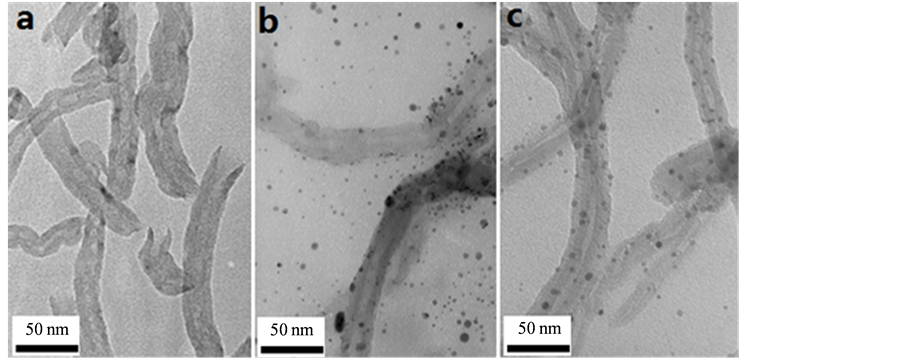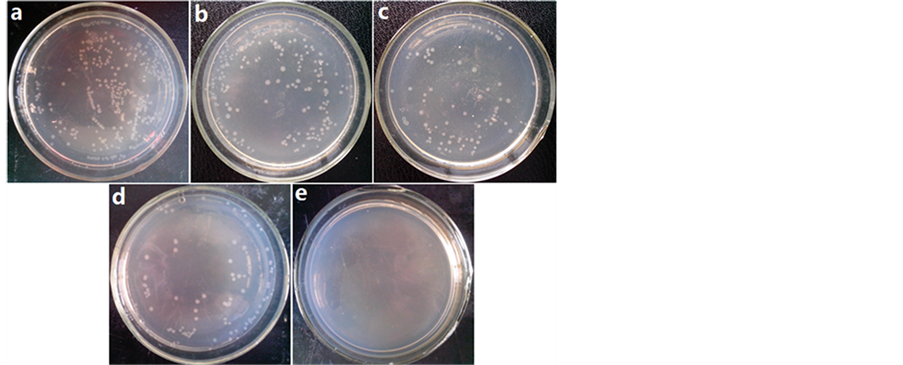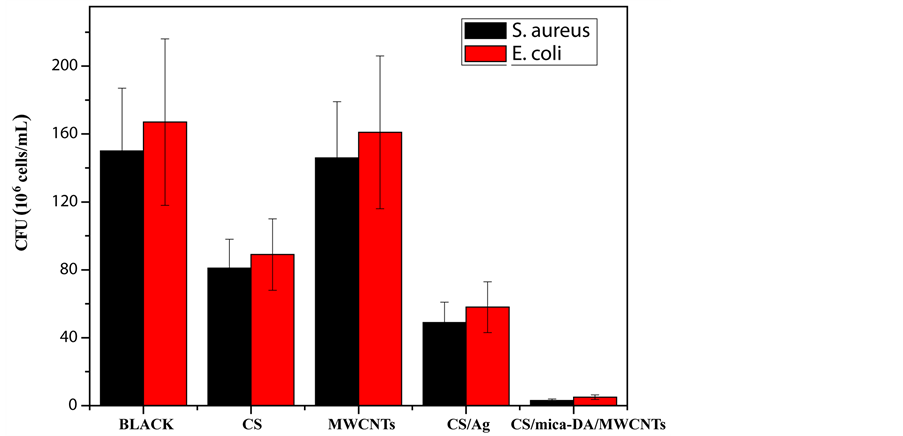1. 引言
纳米银(Ag nanoparticles, Ag NPs)是具有纳米尺寸的金属Ag颗粒,具有小尺寸效应、量子效应、大的比表面积等特点 [1] [2] 。作为一种新型的无机抗菌剂,具有持续杀菌时间长、广谱抗菌性、无耐药性等优点 [3] [4] 。但是纳米银在还原过程易造成团聚 [5] ,影响其抑菌性能。实验过程中一般加入分散剂或保护剂阻止纳米银的团聚 [6] ,常用的高分子类表面活性剂存在增加产物提纯的难度、增加实验成本等缺点。壳聚糖(CS)是一种可生物降解的多糖大分子,分子结构中含有游离氨基和羟基,这些基团有良好的化学反应特性,同时在一定的pH条件下对金属离子具有螯合作用[7] 。因此,壳聚糖可作为分散剂或保护剂加入以阻止纳米银的团聚[8] ,减小复合溶胶中杂质的引入,同时壳聚糖中活性基团的存在使其可作为一种模板参与配位反应。纳米银在实际应用中易流失导致抑菌性能丧失,因此常利用载体将纳米银固定以起到长效抑菌的作用。多壁碳纳米管(MWCNTs)除了具有独特中空管状结构外,还具有较大的比表面积[9] ,吸附能力很强且表面可修饰多种官能团[10] ,将其用做纳米银粒子的载体,有着重要的研究意义[11] 。不过,由于多壁碳纳米管表面活性位点较少,限制了纳米银粒子负载量,在实际应用中多通过酸化处理增加活性基团,但酸化处理会破坏碳纳米管的结构,使其物理性能降低。聚多巴胺(PDA)具有环境友好、强粘附性等特点,在吸附基体以后还能够作为吸附其它物质的载体,是一种很好的作为二次反应平台的物质[12] 。使用PDA改性MWCNTs,可以避免氧化改性过程中对碳管造成的损害,而且PDA还具有弱的还原性及吸附作用银氨离子的作用可以还原Ag NPs粒子并将其固定在基体表面[1] [13] 。
基于以上研究,本实验采用原位还原法制备聚多巴胺包覆碳纳米管/纳米银/壳聚糖复合溶胶(CS/PDA-MWCNTs/Ag),其中,以AgNO3作银源,CS作为保护剂和稳定剂,PDA-MWCNTs作为模板材料,利用聚多巴胺膜层的还原性通过原位还原法制备得到CS/PDA-MWCNTs/Ag。所制备的复合材料可进一步作为抑菌涂料或其他材料的添加剂,在当今无锡、低毒的环境友好型防污剂发展趋势下,该类环境友好型防污材料在防污领域具有极大的应用前景。
2. 实验部分
2.1. 试剂和仪器
多壁碳纳米管(MWCNTs):纯度 > 95%,平均直径11 nm (阿法埃莎天津化学有限公司);壳聚糖(CS,Mr ≥ 5万和Mr ≥ 10万,脱乙酰度 > 90%),阿拉丁化学试剂有限公司;盐酸多巴胺,阿法埃莎天津化学有限公司;冰醋酸、硝酸银及氯化钠均为分析纯,购自国药集团化学试剂有限公司。蛋白胨、牛肉浸膏及营养琼脂(北京双旋微生物培养基制品厂),大肠杆菌、金黄色葡萄球菌(青岛日水生物技术有限公司)。
DF-101s集热式磁力加热搅拌器(金坛市医疗仪器厂),PHS
-25C
pH-酸度计(上海宇隆仪器有限公司),HDZX-30FBS立式压力蒸汽灭菌器(上海申安医疗器械厂),Hitachi H-700透射电镜(日本电子公司)。Bruker D8 ADVANCE X射线衍射仪(德国布鲁克公司)。
2.2. 实验方法
2.2.1. PDA-MWCNTs复合材料的制备
称取30 mg多巴胺,加入Tris-HCl缓冲溶液50 mL,在避光条件下磁力搅拌30 min,称取10 mg的多壁碳纳米管置于上述溶液中,在25℃下水浴24 h,将产物抽滤,60℃真空干燥10 h后得到PDA-MWCNTs。
2.2.2. 壳聚糖基抑菌复合材料的制备
称取15 mg的PDA-MWCNTs充分分散于1 wt%的壳聚糖醋酸水溶液。加入5 mL硝酸银溶液(
10 mM
),搅拌30 min使Ag+与CS充分交联、均匀分散,反应至溶液颜色不再加深,即得到CS/PDA- MWCNTs/Ag复合材料。
称取15 mg的MWCNTs充分分散于1 wt%的壳聚糖醋酸水溶液。加入5 mL硝酸银溶液(
10 mM
),搅拌30 min使Ag+与CS充分交联、均匀分散,然后加入硼氢化钠作为还原剂(反应体系中nAgNO3:n还原剂 = 1:2,确保还原反应进行完全),反应至溶液颜色不再加深,即得到CS/MWCNTs/Ag复合溶胶。
量取5 mL硝酸银溶液(
10 mM
),充分分散于1 wt%的壳聚糖醋酸水溶液,搅拌30 min使Ag+与CS充分交联、均匀分散,然后加入硼氢化钠作为还原剂(反应体系中nAgNO3:n还原剂 = 1:2),反应至溶液颜色不再加深,即得到CS/Ag复合溶胶。
2.2.3. CS/PDA-MWCNTs/Ag复合材料的抑菌测试
将待测菌种(大肠杆菌、金黄色葡萄球菌)进行活化后,进行菌种转移至含有不同抑菌材料的液体培养基中,在恒温震荡培养箱中37℃、100 rpm培养24 h。经梯度稀释将培养后的待测样品液稀释106倍,移取一定量稀释样液涂布到培养皿平板上,涂布均匀,培养24 h,对平板进行计数分析。
将活化培养后的菌液稀释梯度稀释10倍后,取一滴滴在血球计数板上,在显微镜下观察计数。
细菌个数/mL = 80个小方格细菌总数/80 × 400 × 10,000 × 稀释倍数
所有试验重复三次,以确保其准确度。
3. 结果与讨论
3.1. 形貌观察
通过透射电子显微镜对样品进行了表面形貌观察,分析CS、PDA-MWCNTs及Ag NPs的复合情况,结果如图1所示。图1(b)是由未经聚多巴胺包覆的多壁碳纳米管通过液相还原法,以AgNO3作银源,CS作为保护剂和稳定剂,以硼氢化钠为还原剂制备得到的CS/MWCNTs/Ag复合材料,MWCNTs管壁上有少量Ag NPs颗粒附着,溶液中均匀分散着大量Ag NPs颗粒;由图1(c)中可看出,不同于原始碳纳米管

Figure 1. TEM images of MWCNTs (a), CS/MWCNTs/Ag (b), CS/PDA-MWCNTs/Ag (c)
图1. MWCNTs (a), CS/MWCNTs/Ag (b), CS/PDA-MWCNTs/Ag (c)的透射电镜照片
管壁光滑且管端打开,图1(a),体系中没有出现别的物相;CS/PDA-MWCNTs/Ag复合溶胶中碳纳米管管径增大,管壁外均匀包覆一层4 nm厚的PDA层,绝大多数Ag NPs颗粒都附着在PDA-MWCNTs的管壁外,溶胶中均匀分散着Ag NPs颗粒,没有发生团聚现象,Ag NPs的粒径约为8~9 nm,充分说明PDA层在反应中还原并固定了Ag NPs,同时,CS在整个体系中起到了分散剂和稳定剂的作用。TEM分析表明,利用PDA-MWCNTs管壁外聚多巴胺膜层还原性原位还原纳米银能有效增加碳纳米管上纳米银的负载量,分散剂CS能较好地避免纳米银的团簇现象,实验得到稳定的CS/PDA-MWCNTs/Ag复合溶胶。
3.2. 物相分析
通过XRD测试进一步证实CS/PDA-MWCNTs/Ag复合物中包覆在碳纳米管上的颗粒为AgNPs。分析图2可知,CS/PDA-MWCNTs/Ag的碳纳米管特征峰非常明显,位于2θ = 25.9˚以及42.9˚的衍射峰,与碳纳米管的(002)、(100)晶面逐一对应,PDA为非结晶聚合物,没有破坏MWCNTs的晶体结构。由于CS无明显的衍射峰,因而在CS/PDA-MWCNTs/Ag复合物的XRD谱图中,没有CS相应的衍射峰,但其整体趋势与CS的趋势相同[7] ,可以说明复合物中CS的存在。在38.0˚、44.2˚、64.4˚、77.5˚处的四个衍射峰分别对应了银的(111)、(200)、(220)、(311)晶面衍射峰 (JCPDS card No4-783),充分说明所制备的CS/PDA-MWCNTs/Ag中,银以金属单质形式存在,与此同时AgNPs的峰形较不尖锐,表明了AgNPs的粒径比较小;同时,复合材料中也明显出现了碳纳米管的衍射峰,证明了AgNPs还原过程中复合材料中碳纳米管晶体结构未被破坏。采用Debye-Scherrer公式计算得到该反应条件制备的AgNPs的平均粒径约为9 nm,与透射电镜照片中观察结果相一致。
3.3. 抑菌性能研究
以不加任何抑菌材料的菌悬液为空白对照,添加不同抑菌材料,使其浓度为0.2 mg/mL,考察了不同材料对大肠杆菌抑菌性能。如图3,(a)为空白试样,从图中可以看出:固体培养基上有大量的菌落生长;加入MWCNTs (图b),菌落数目稍有减少;加入CS (图c),表现出明显的杀菌效果,与空白试样相对比菌落数减少近1/2;壳聚糖与纳米银复合后(图d),CS/Ag的抑菌效果更加显著,其菌落数与空白试样相比降低为空白试样的1/5;加入CS/PDA-MWCNTs/Ag复合物 (图e),细菌的生长被完全抑制,固体培养基表面无菌落生长,抑菌率达到100%。
为了更准确地比较不同材料的抑菌性能差异,又进一步进行计数法抑菌实验表征了MWCNTs、CS、CS/Ag及CS/PDA-MWCNTs/Ag对大肠杆菌和金黄色葡萄球菌的抑菌性能。以不加任何抑菌材料的菌悬液做空白对照,添加不同抑菌材料(0.2 mg/mL),分别考察不同细菌培养14 h后菌悬液的细菌浓度情况。
如图4,其中,添加了碳纳米管的菌悬液细菌浓度比空白试样有所降低,表现了一定的抑菌性,碳基材料具有低毒性[14] ;添加了壳聚糖的菌悬液细菌浓度与空白试样相比显著降低,细菌数量减少了近一半;壳聚糖与Ag NPs复合后,由于Ag NPs的高效、广谱抑菌性,CS/Ag的抑菌效果更加显著,其菌悬液细菌浓度与空白试样相比降低为空白试样的1/6;由于MWCNTs的加入,为Ag NPs的复合制备提供了更多的活性位点,使得材料中Ag NPs的含量增加,因此CS/PDA-MWCNTs/Ag复合材料表现出了优异的抑菌性,其浓度为0.2 mg/mL时材料的抑菌率达到100%。总之,样品的抑菌性CS/PDA-MWCNTs/Ag > CS/Ag > CS > MWCNTs,与平板菌落抑菌实验的结果相一致。

Figure 2. XRD patterns of CS/PDA-MWCNTs/Ag
图2. CS/PDA-MWCNTs/Ag的XRD谱图

Figure 3. Antibacterial effect against E. coli of different materials: (a) the blank control group; (b) MWCNTs; (c) CS; (d) CS/Ag and (e) CS/ PDA-MWCNTs/Ag
图3. 不同抑菌材料对大肠杆菌的平板菌落法抑菌效果对比图 (a) 空白对照;(b) MWCNTs;(c) CS;(d) CS/Ag;(e) CS/PDA-MWCNTs/Ag

Figure 4. Comparison chart of antibacterial effect against E. coli, S. aureus bacteria of different antibacterial materials
图4. 不同抑菌材料对大肠杆菌和金黄色葡萄球菌的抑菌效果对比图
4. 结论
以PDA-MWCNTs为基础模板物质,以AgNO3作银源,壳聚糖既作为保护剂和分散剂,又作为一种模板参与配位反应,PDA原位还原得到CS/PDA-MWCNTs/Ag复合抗菌剂。与CS/MWCNTs/Ag复合材料相比,无需添加额外的还原剂、分散剂,避免了引入杂质;同时由于PDA-MWCNTs的加入,为纳米银的复合制备提供了更多的活性位点,使得材料中纳米银的含量增加更加稳定,因此CS/PDA-MWCNTs/Ag复合抗菌剂表现出广谱、高效的抑菌性能。